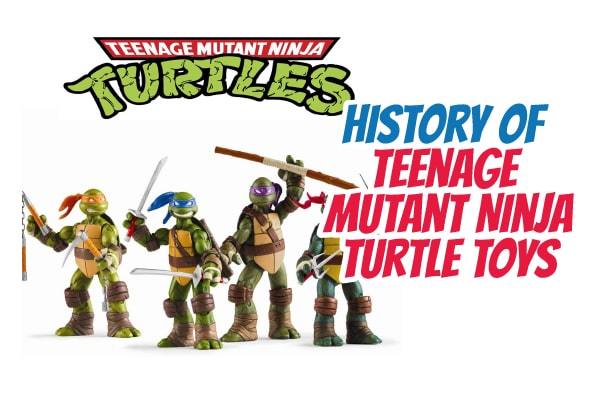A Brief History of Teenage Mutant Ninja Turtle Toys

If you’re a child of the 1980s or ’90s or have children now, you’re probably well aware of the phenomenon known as Teenage Mutant Ninja Turtles. You might even think it’s hard not to know anything about the Turtles at all, given that they’re one of the most popular comic series and toy lines in recent history.
Teenage Mutant Ninja Turtles wasn’t always so successful, though. In fact, the Turtles had quite humble origins you might find unimaginable. Even as the two starving artists who conceived the Turtles worked on developing the original comic series, they had difficulty finding their audience and selling their work.
When Teenage Mutant Ninja Turtles hit its stride, it seemed nothing could stop it. The original comic books spawned a television miniseries, which generated a full television series. That success then led to toys, films, and more. We’ve taken a good look at the history of The Ninja Turtles Turtles to give you information on one of the most successful comics today.
Contents
Origin Story
Teenage Mutant Ninja Turtles began as a simple sketch from Kevin Eastman and Peter Laird in 1983. Both were struggling artists in Northampton, Massachusetts. As a joke, Eastman drew a turtle standing on its hind legs with nunchucks and an eye mask, and called it a ninja turtle.
At that point, Laird decided to counter the joke with his own turtle, and Eastman hit back with four turtles who all had different ninja-style weapons, and they added the words “teenage mutant” to “ninja turtle.”
That was the birth of the Teenage Mutant Ninja Turtles.
From there, Eastman and Laird created an entire comic book for the Turtles, which was supposed to be a standalone story. At first, they tried using Japanese names for the quartet. However, they ultimately went with the Renaissance artists Leonardo (DaVinci), Raphael (Sanzio da Urbino), Michelangelo (di Lodovico Buonarotti Simoni), and Donatello (di Niccolo di Betto Bardi) because the Japanese names they tried didn’t pan out.
Birth of the Comic Series
One year later, Eastman and Laird started their own studio called Mirage Studios. They decided on the name “Mirage” because they worked out of Laird’s living room instead of an actual studio. They used $700 in savings and tax refunds, along with another $1,300 loan, to print 3,000 copies of the comic.
They sold out within a few weeks and printed 6,000 more. Those sold out as well, they paid off their loan and began making a profit. Even though the comic was a one-off, they realized they might have hit upon something that resonated with comic fans.
Teenage Mutant Ninja Turtles remained part of Mirage until 1995. Also, Archie Comics ran 72 issues of its own from 1988 to 1995.
Running into Problems
Mirage Studios handed Teenage Mutant Ninja Turtles over to Image Comics in 1996. However, Image decided to take the Turtles in the absolute wrong direction, turning Raphael into the new Shredder, Donatello into a cyborg, and Splinter into a bat, and making other strange things happen.
Image Comics’ series was canceled in 1999.
Eastman then brought the Turtles back to Mirage in 2001, and the Image Comics years faded into the dustbin of comic history and are no longer considered part of the Turtles canon.
Marvel Comics’ Influence
Many things in Teenage Mutant Ninja Turtles contain nods to Marvel’s Daredevil comic. The Foot Clan, for instance, is loosely based on The Hand ninja clan in Daredevil. Splinter is a hat-tip to Stick, who is Daredevil’s sensei.
The Turtles and Daredevil also have similar origin stories.
Television, Film, and Toys
The toy company, Playmates, created the first Teenage Mutant Ninja Turtles toys, but they wouldn’t do so without an idea of how well they would do.
They developed a five-part miniseries to get an idea of how much demand they’d find. Unfortunately, Playmates had to air the miniseries three times before they gained anything resembling an audience.
However, once that happened, Playmates ordered more episodes, and the T.V. cartoon ran from 1988 to 1996, with a total of 188 episodes. Three live-action Teenage Mutant Ninja Turtles films came out in the 1990s as well. The most popular Turtles film is the first, which grossed over $100 million.
Later films include a CGI version in 2007 and a couple of new live-action movies in 2014 and 2016. There’s also an odd crossover film between Teenage Mutant Ninja Turtles and Batman that hit the screens in 2019.
The first Turtle toys came out in 1988, and between then and 1997, Playmates produced 400 action figures and many more playsets and vehicles. These toys were the third most popular toys in sales, right behind G.I. Joe and Star Wars, and one of the most successful toy lines in history.
In 2018, Nickelodeon relaunched Teenage Mutant Ninja Turtles, with Playmates launching a new line of toys to go with it. In addition to the action figures, they produced new versions of weapons, a variety of giant figures that stand almost one foot tall, role-play toys, and vehicles from the new series.
Final Thoughts
Whether you’re a child of the 1980s, a younger person, or a parent, you probably know Teenage Mutant Ninja Turtles in some form. The comic has a long, storied history spanning nearly 30 years, beginning with a single joke sketch.
They had a rough start. Problems finding audiences for the comic books, and then later for the original T.V. series arose from the start. However, once the original creators, studios, networks, and toymakers found that audience, Teenage Mutant Ninja Turtles became a juggernaut in the comic world.
Indeed, because of the Turtles’ popularity, you’ll find countless toys spanning nearly the same period as the comic and T.V. series themselves. Even today, with a relaunched series and new films in the works, Teenage Mutant Ninja Turtles remains a comic and animated staple for children and adults alike.
